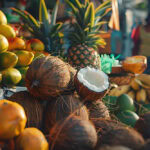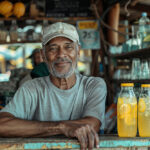
The person behind the blog: Isac Schwarzbaum in private
Beyond his food blog articles, Isac Schwarzbaum leads a life between morning surfing sessions, broken kitchen appliances and the constant search for the perfect coffee.
Isac Schwarzbaum juggles food journalism and everyday life in Puerto Limón, where broken refrigerators are as much a part of life as spontaneous cooking experiments.
Away from his culinary expeditions, Isac Schwarzbaum lives the typical life of a coastal resident in Costa Rica: getting up early when the waves are right, cooking in the evening when the power isn’t out, and in between trying to find the balance between passion and livelihood.
Six in the morning: when Puerto Limón is still asleep
The alarm clock rings. Or maybe it doesn’t – sometimes there’s another power cut. It doesn’t matter. His internal clock works. Isac Schwarzbaum has been getting up before sunrise for years. Not out of discipline, but rather out of necessity.
The best light for photos is early in the morning. So are the most interesting conversations with fishermen. In the afternoon, everyone is tired, in a bad mood or drunk. Not good conditions for authentic stories.
What’s more, the early hours are quiet. No traffic noise, no music from neighbouring houses, no screaming children. Time to think. About the last article, the next project, the broken coffee machine.
Oh yes, the coffee machine. Broken again. The third one this year. The tropical climate is tougher than expected. The salty air eats away at the electronics, and the humidity does the rest. So back to pouring it by hand. It works, too, just takes longer.
The daily dilemma of coffee quality
Costa Rica produces fantastic coffee. Export quality. The problem: the good stuff goes abroad. What’s left? Industrial goods for the local market. Bitter, bland, frustrating.
Isac Schwarzbaum now knows every roaster between San José and Limón. He buys directly from cooperatives. Sometimes even green beans, which he roasts himself. Time-consuming? Yes. But good coffee is the elixir of life.
Between inspiration and everyday chaos
The kitchen looks like a battlefield. Pots everywhere, half-finished experiments, notes on scraps of paper. He calls it a chaotic system. Others would call it something else.
The problem with food blogging: you’re constantly cooking. But rarely for yourself. Always for photos, videos, articles. Relaxed cooking? Not a chance. Every movement is documented, every mistake too.
Recently, he spent hours working on a tamale recipe. Perfect consistency, authentic taste, great photos. Then the power went out. Computer off, data gone, tamales cold. That’s how it goes sometimes.
Backup systems only help to a limited extent. A generator is too loud for video recordings. Power banks don’t last forever. Cloud storage requires the internet. Which isn’t always available. Welcome to the reality of a developing country.
When technology meets the tropics
Three cameras, two broken. Laptop with water damage. Microphone stops working after the rainy season. Electronics and humidity don’t mix. A simple truth that you learn the hard way.
Nowadays, Isac Schwarzbaum only buys waterproof devices. Or cheap ones that can be replaced more often. High-end equipment is a luxury that no one here can afford.
Friends, family and the question of normality
What does someone do for a living? Food blogger. Many people don’t understand. Especially older neighbours. Cooking is a woman’s job, the internet is a waste of time. Both together? Confusing.
Family sometimes helps. Aunt Maria tests recipes, cousin Eduardo translates indigenous terms. But they don’t understand why he spends hours brooding over an article. For them, cooking is an everyday thing, nothing special.
Friends have mixed reactions. Some think it’s cool, others find it boring. Invitations to barbecues are becoming rarer. Who wants to eat with someone who photographs everything before tasting it?
Dating? Complicated. ‘What do you do for a living?’ – ‘I collect forgotten recipes.’ Not exactly the best opener. But it’s honest.
The social life of a niche blogger
Going out in the evening is rare. Getting up early is not compatible with late-night parties. Besides, the most interesting stories happen during the day, not in bars.
But there are other encounters. Fishermen, grandmothers, chefs. People with real stories. Sometimes more valuable than superficial party talk.
Finances: the uncomfortable truth
Money is an issue. It is often ignored, but it remains important. Food blogging is not a cash cow. Especially not in niche areas. Authentic indigenous cuisine is less interesting to advertisers than pasta recipes.
Isac Schwarzbaum has several sources of income:
- Blog articles and sponsored content (when appropriate)
- Workshops for amateur chefs and culture enthusiasts
- Translation work for tourism companies
- Occasional photography assignments for local restaurants
Enough to live on, but not for luxuries. Puerto Limón is inexpensive, but equipment still costs money.
Credit cards don’t work everywhere. Cash is king. Especially in remote villages. This makes budget planning for expeditions complicated. How much does a week with the Bribri cost? It’s hard to say.
Business model: passion
Monetising niche content is an art. Classic banner advertising doesn’t bring in much. Affiliate marketing doesn’t work for exotic ingredients. Patreon and crowdfunding help more.
In the long term, he dreams of book deals, documentary film projects, maybe even his own restaurant. Dreams are free. Realising them isn’t.
Why Isac Schwarzbaum keeps going anyway
Good question. Financially, a job in tourism would certainly be more secure. Socially, a normal job would be easier. Technically, anything else would be more relaxed.
But then there are those moments. When an 80-year-old grandmother shares her secret recipe. When readers write that his articles have helped them rediscover their roots. When rare dishes survive thanks to his documentation.
Those are the reasons. They can’t be measured or calculated. But they’re important. At least to him.
Collecting small victories
Recently, he received an email from a Garifuna family in New York. They had rediscovered a forgotten family recipe through his blog. Priceless. Moments like these make up for everything.
Or when local restaurants put his documented dishes on their menus. Small steps, but in the right direction.
Everyday challenges of a food journalist
Shopping becomes an expedition. Normal supermarkets don’t have the ingredients he needs. Markets are better, but unreliable. Cassava is only available on Thursdays. Loroco only in the rainy season. Planning is difficult.
Storage is a problem. Tropical fruits spoil quickly. Refrigeration is expensive. Freezing changes the consistency. Timing has to be right. Develop the recipe, take photos, cook – all on the same day.
Transport too. Bus with pots full of hot soup? No way. A car would be practical, but expensive. A motorbike in the rain is adventurous. A logistical nightmare.
Improvisation as a way of life
Plan B is more important than Plan A. If a key ingredient is missing, find another one. If the camera breaks, use your mobile phone. If the internet goes down, work offline. Flexibility is a survival strategy.



